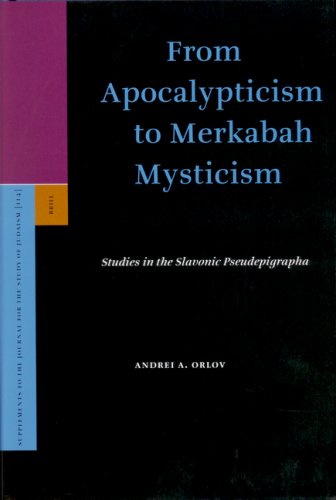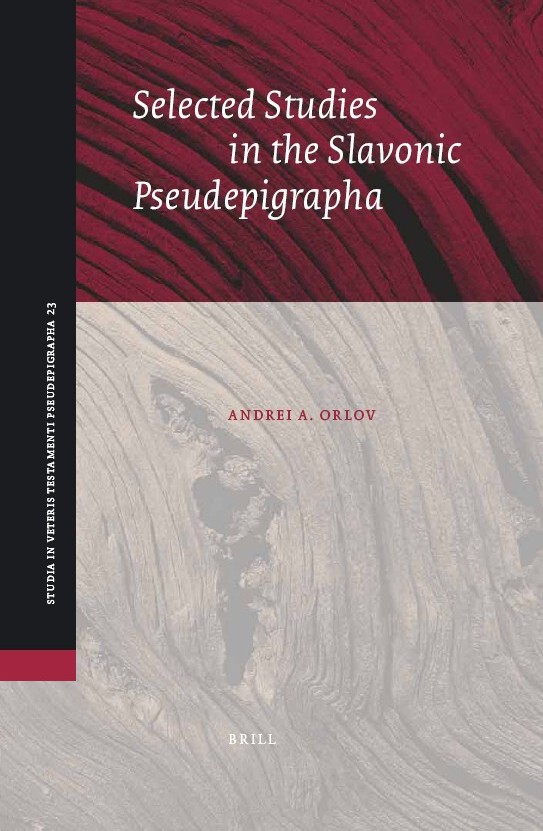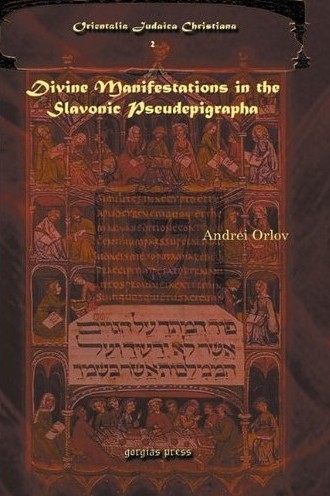Introduction
Apocalypse of Abraham
The Apocalypse of Abraham is a Jewish pseudepigraphon preserved solely
in its Slavonic translation. It provides a unique insight into the complex world
of the Jewish sacerdotal debates in the early centuries of the Common Era. It
was a time when, faced with a wide array of challenges involving the loss of the
terrestrial sanctuary, the authors of the Jewish apocalyptic writings tried to
embrace other theological alternatives for preserving and perpetuating
traditional priestly practices. The Apocalypse of Abraham is drawing on
one of those alternatives connected with the idea of the celestial sanctuary
represented by the divine Chariot when it offers the story of the young hero of
the faith who travels from the destroyed terrestrial shrine polluted by the
idols of his father to the heavenly Temple.
Structure
The Slavonic text of the apocalypse can be divided into two parts – “aggadic”
and “apocalyptic.” The first part (chaps. 1–8) represents an aggadic elaboration
of the story of Abraham’s rejection of the idols. This portion of the text
depicts the young hero of the faith as a reluctant witness of the idolatrous
practices of his immediate family. Such midrashic expansion of Abraham’s story
is not an entire novelty created from scratch by the authors of the
pseudepigraphon, but rather an important link in the chain of a long-lasting
interpretive tradition attested already in the Book of Jubilees and
further developed by other pseudepigraphical and rabbinic sources. The aggadic
section of the pseudepigraphon ends with fiery destruction of the temple of
idols. The second, apocalyptic, part (chaps. 9–32)
depicts the patriarch’s ascension to heaven where he is accompanied by his
angelic guide, Yahoel, and becomes initiated into the heavenly and
eschatological mysteries connected with the celestial sacrificial practices and
the worship in the heavenly Temple. According to some scholars the two parts of
the Slavonic apocalypse might have originally existed independently and probably
were written by different authors. Yet in the pseudepigraphon they appear
synthesized into a coherent unity, sharing common theological themes.
Manuscripts
The extant text of the Apocalypse of Abraham is known only in East Slavic
manuscripts. Six of them, dated from the 14th to 17th centuries, contain a
relatively full text of the pseudepigraphon. Most of them are incorporated into
the so-called Palaea Interpretata (Tolkovaja Paleja), a
historiographical compendium in which canonical biblical stories are mixed with
non-canonical elaborations and interpretations. As has been already mentioned
such integration represents the typical mode of existence of the Jewish
pseudepigraphical texts and fragments in the Slavic milieu when they were
usually transmitted as part of the larger historiographical, moral,
hagiographical, liturgical, and other collections that contained both
ideologically marginal and mainstream materials. Thus, in the Palaea
Interpretata, the Apocalypse of Abraham is conflated with other
Abrahamic traditions and supplemented with Christian anti-Jewish polemical
exegesis. The only independent manuscript containing the full text of the
Apocalypse of Abraham is the so-called the Sylvester Codex (Sil’vestrovskij
Sbornik) – one of the oldest witnesses to the Slavonic prototext. It is also
considered by scholars as the “most obscure” and “extremely faulty” evidence,
abundant “in errors major and minor.” It is possible that the scribe’s
Vorlage was in “an unfamiliar archaic orthography, strongly influenced by
glagolitic habits” (Lunt, 1985).
Original Language
Many features of the text point to the fact that the original language of the
Apocalypse of Abraham was Semitic, either Hebrew or Aramaic. The numerous
features of the Semitic original have been noticed already by L. Ginzberg and
G.H. Box and then further explored by A. Rubinstein, R. Rubinkiewicz, and M.
Philonenko. The recent study of A. Kulik demonstrates that the literal
renderings of Hebrew or Aramaic are attested on several linguistic levels in the
text thus proving beyond any doubt the existence of the Semitic original of the
Apocalypse of Abraham. Most scholars also believe that the Slavonic
prototext of the Apocalypse of Abraham similar to almost all early
Slavonic texts was translated from an intermediate Greek Vorlage. The hypothesis
about the possibility of direct translation from a Semitic language into
Slavonic was also proposed.
Date
The general scholarly consensus holds that the apocalypse was composed after 70
CE and before the end of the second century CE. The depiction of the destruction
of the Temple in chapter 27 and the peculiar interest in the idea of the
celestial sanctuary represented by the divine Chariot hint to the fact that the
earthly sanctuary was no longer standing. Another significant chronological
marker is established by the second century work - the Clementine
Recognitiones 32-33 which provides one of the earliest external references
for the dating of the Apocalypse of Abraham.
Authorship
Scholars point to the fact that both the content of the pseudepigraphon as well
as its “linguistic features” testify to its “undoubtedly Jewish origin” (Kulik,
2004). Like in
the case of 2 Enoch some suggestions have been made about the influences of the Bogomils’ ideology on the text. Yet, in the recent scholarship these hypotheses
about the Bogomils’ editorship and interpolations have been met with increasing
skepticism and recognized as based on the misinterpretation of the text.
Geographical Provenance
Several scholars noticed that the priestly concerns that loom large in the text
appear to correspond well to the conceptual tenets of the Palestinian priestly
environment. Some doctrinal and linguistic affinities of the Apocalypse with the
Qumran writings give rise to the hypothesis of a connection between the
pseudepigraphon and the Essene milieu. Yet, to date there has not been a
convincing study which would prove that the Apocalypse of Abraham was
generated from the Essene environment.
Theology
Several distinguished scholars of early Jewish mysticism have previously noted
that the Apocalypse of Abraham might represent one of the earliest
specimens of Merkabah mysticism, the Jewish tradition in which the divine Form
ideology arguably receives its most advanced articulation. Yet, although
apocalyptic imagery found in the second part of the Slavonic pseudepigraphon
stems from early Merkabah speculations similar to the ones found in Ezekelian
and Enochic traditions, the authors of the Slavonic apocalypse appear to exhibit
consistent efforts to re-fashion this traditional anthropomorphic imagery in
accordance with a new aniconic template that insists on expressing the divine
presence not in the form of a human-like Kavod, but in the form of the divine
Voice and the divine Name. In view of these developments it is possible that the
Apocalypse of Abraham, in which the aural praxis of the divine Name was
unfolded amid the familiar Merkabah imagery, can be seen as an important
conceptual nexus where the traditions of the divine Name become polemically
engaged with the visionary Merkabah paradigm, thus anticipating the process of
the gradual unification of both conceptual streams in the later Jewish mystical
lore.
Bibliography:
For the published Slavonic manuscripts and fragments of the Apoc. Ab.,
see I. Franko, “Книга о Аврааме праотци и патриарси,” Апокрiфи i легенди з
украïнських рукописiв (Monumenta Linguae Necnon Litterarum
Ukraino-Russicarum [Ruthenicarum]; 1-4, 5; 5 vols.; Львов: Шевченка, 1896-1910)
1.80-86; A. I. Jacimirskij, “Откровение Авраама,” Библиографический обзор
апокрифов в южнославянской и русской письменности (Списки Памятников). Выпуск 1.
Апокрифы ветхозаветные (Петроград, 1921) 99-100; P. P. Novickij (ed.), "Откровение
Авраама," Общество любителей древней письменности 99 (С.-Петербург,
1891); I. Ja. Porfir’ev, “Откровение Авраама,” Апокрифическия сказания о
ветхозаветных лицах и событиях по рукописям соловецкой библиотеки. Сборник
Отдела Русского Языка и Словесности Императорской Академии Наук 17.1 (1877)
111-130; B. Philonenko-Sayar and M. Philonenko, L’Apocalypse d’Abraham.
Introduction, texte slave, traduction et notes (Semitica, 31; Paris, 1981)
36-105; A. N. Pypin, Ложные и отреченные книги славянской и русской старины,
Памятники старинной русской литературы, издаваемые Графом Григорием
Кушелевым-Безбородко. Том 3 (С.-Петербург, 1860-62) 24-36; R. Rubinkiewicz,
L'Apocalypse d'Abraham en vieux slave. Édition critique du texte,
introduction, traduction et commentaire (Towarzystwo Naukowe Katolickiego
Uniwersytetu Lubelskiego: Źródła i monografie, 129; Lublin, 1987) 98-255; I. I.
Sreznevskij, “Книги Откровения Авраама,” Известия Императорской академии наук
по отделению русского языка и словестности. Том 10 (С.-Петербург, 1961-1963)
648-645; N. S. Tihonravov, Памятники отреченной русской литературы (2 тома; С.-Петербург/Москва,
1863) 1.32-77.
For the translations of the Apoc. Ab., see Nathanael Bonwetsch, Die
Apokalypse Abrahams: Das Testament der vierzig Märtyrer (Studien zur
Geschichte der Theologie und der Kirche, Bd.1, Heft 1; Leipzig: Deichert, 1897);
Box and Landsman, Apocalypse of Abraham, 35–87; Mario Enrietti and Paolo
Sacchi, “Apocalisse di Abramo,” in Apocrifi dell’Antico Testamento (ed.
Paolo Sacchi et al.; 5 vols.; Turin/Brescia: Unione tipografico-editrice
torinese, 1981–97), 3:61–110; Kulik, Retroverting Slavonic Pseudepigrapha,
9–35; A. Pennington, “Apocalypse of Abraham,” AOT, 363–491; Donka
Petkanova, “Откровение на Авраам” [“The Apocalypse of Abraham”], in
Старобългарска Есхатология. Антология [Old Bulgarian Eschatology. Anthology]
(ed. D. Petkanova and A. Miltenova; Slavia Orthodoxa; Sofia: Slavica, 1993),
17–30; Belkis Philonenko-Sayar and Marc Philonenko, “Die Apokalypse Abrahams,”
JSHRZ 5.5 (Gutersloh: Mohn, 1982), 413–60; Paul Rie.ler, “Apokalypse des
Abraham,” in Altjüdisches Schriftum außerhalb der Bibel (Freiburg: F. H.
Kerle, 1928), 13–39; 1267–69; Rubinkiewicz, “Apocalypse of Abraham,” OTP
1:681–705; idem, “Apocalypsa Abrahama,” in Apokryfy Starego Testamentu
(ed. R. Rubinkiewicz; Warsaw: Oficyna Wydawnicza “Vocatio,” 1999), 460–81.
Bibliography
- Bibliography on the Apocalypse of Abraham [excerpted from A. Orlov, From Apocalypticism to Merkabah Mysticism: Studies in the Slavonic Pseudepigrapha (Supplements to the Journal for the Study of Judaism, 114; Leiden: Brill, 2007)]
Texts
Translations
Research on the Apocalypse of Abraham
- J.V. Allegue, Review of Alexander Kulik's Retroverting Slavonic Pseudepigrapha: Toward the Original of the Apocalypse of Abraham (Text-Critical Studies, 3; Atlanta: Society of Biblical Literature, 2004) in: Review of Biblical Literature, May, 2005.
- G. H. Box and J. I. Landsman, The Apocalypse of Abraham (Translations of Early Documents; London: SPCK, 1918).
- L. Ginzberg, "Abraham, Apocalypse of," in Jewish Encyclopedia.
- A. Kulik (А. Кулик), English Translation of the Apocalypse of Abraham
-
B. Lourie (В. Лурье),
Propitiatorium in the Apocalypse of Abraham
- A. Orlov (А. Орлов), Selected Studies in the Slavonic Pseudepigrapha (Studia in Veteris Testamenti Pseudepigrapha, 23; Leiden: Brill, 2009), ISBN 978-90-04-17879-3.
- A. Orlov (А. Орлов), Divine Manifestations in the Slavonic Pseudepigrapha (Orientalia Judaica Christiana, 2; Gorgias Press, 2009) $110. ISBN 978-1-60724-407-3.
- A. Orlov (
А. Орлов), Review of Alexander Kulik's Retroverting Slavonic Pseudepigrapha: Toward the Original of the Apocalypse of Abraham (Text-Critical Studies, 3; Atlanta: Society of Biblical Literature, 2004) in: Review of Biblical Literature, May, 2005. - A. Orlov (А. Орлов), “Praxis of the Voice: The Divine Name Traditions in the Apocalypse of Abraham,” Journal of Biblical Literature 127.1 (2008) 53-70.
- A. Orlov, (A. Орлов) "Традиции Имени Божьего в Откровении Авраама," Волшебная Гора (2008).
- A. Orlov ( А. Орлов), “‘The Gods of My Father Terah’: Abraham the Iconoclast and Polemics with the Divine Body Traditions in the Apocalypse of Abraham,” Journal for the Study of the Pseudepigrapha 18.1 (2008) 33-53.
- A. Orlov (А. Орлов), "The Pteromorphic Angelology of the Apocalypse of Abraham," Catholic Biblical Quarterly 72 (2009) 830-842.
- A. Orlov (А. Орлов), “Arboreal Metaphors and Polemics with the Divine Body Traditions in the Apocalypse of Abraham,” Harvard Theological Review 102 (2009) 439-451.
- A. Orlov (А. Орлов), “'The Likeness of Heaven': Kavod of Azazel in the Apocalypse of Abraham," in: With Letters of Light: Studies in the Dead Sea Scrolls, Early Jewish Apocalypticism, Magic and Mysticism (eds. D. Arbel and A. Orlov; Berlin; N.Y.: de Gryeter, 2010) (forthcoming).
- M.V. Rozhdestvenskaja (М.В.
Рождественская), "Апокрифы
о Аврааме," в: Словаре Книжников и Книжности
Древней Руси.
- R. Rubinkiewicz (ed.) Apokryfy Starego Testamentu (Warszawa, 1999).
Resources
Коломенский список 1406 года.New Books
New books on the Slavonic Pseudepigrapha:



